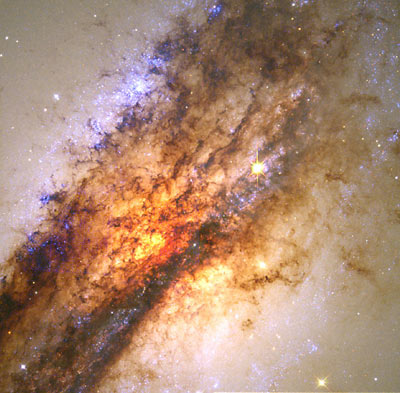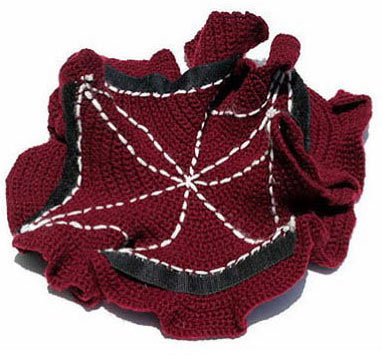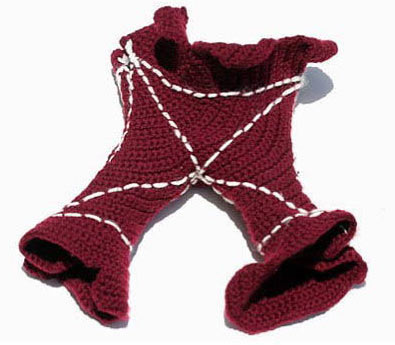 |
|
|||
|
Hyperbolic Space online exhibit - Introduction Model galleries Press and other resources |
Hyperbolic
Space |
|||
| For Isaac Newton and his contemporaries, the space of our universe was Euclidean – an endless and formless void. Most mathematicians and philosophers of the early modern period were so enamored of this concept, that Immanuel Kant argued physical space must be this way. But the mathematical discovery of hyperbolic space in the early nineteenth century raised the possibility that perhaps nature had other options. Maybe space wasn’t Euclidean after all, but some other, more interesting, structure. As the French mathematician Henri Poincaré adroitly noted: ‘One geometry cannot be more true than another; it can only be more convenient.’ While Euclidean geometry may well be convenient for the human mind, that does not mean nature has chosen it for her ultimate temple. |
||||
 |
||||
| A massive black hole hidden at the center of nearby galaxy, Centaurus A, feeds on a smaller galaxy in a spectacular collision. Image Credit: NASA/ESA/STScI | ||||
In the late nineteenth century physicists tried to see if they could detect a cosmic deviation from Euclidean norms by measuring the angles between distant stars. If the universe wasn’t flat then the angles between three stars in a triangular configuration wouldn’t add up to 180¾. As we saw in the previous section, if the universe was spherical, the angles would sum to more than 180¾; if it was hyperbolic, they would sum to less. All measurements, however, revealed the standard 180¾ and for most of the past century the evidence has pointed to a Euclidean cosmos. In the past two decades, however, a problem has arisen which suggests that perhaps our universe may be hyperbolic. If that is so then it will also be finite – not the infinite void of classic physics textbooks. The idea of a finite hyperbolic universe may sound bizarre, but just as we can construct finite Euclidean forms from a piece of paper, so we can construct finite hyperbolic spaces from hyperbolic paper. Take a piece of regular paper (which is a Euclidean surface) and wrap it into a cylinder. The object you are holding is still a Euclidean surface – because every small section of it remains mathematically flat. Now imagine that you wrapped the ends of the cylinder around to connect together at the ends so the resulting form was like a donut. If you actually try to do this, the paper will crease and the surface will not stay flat. However if we allow ourselves to make this move in a fourth dimension the resulting donut would have a surface that was perfectly flat everywhere. This donut or torus shape is an example of a 2 dimensional space that is both finite and Euclidean. Now we may ask: What would happen if we tried a similar construction with hyperbolic paper? Again, we can turn to Dr Taimina’s crochet models for help in visualizing the problem. |
||||
 |
||||
We start with a piece of hyperbolic “paper” (cloth would be a better word perhaps), this time in the shape of an octagon. Just as we wrapped our Euclidean paper into a cylinder by joining two opposite sides together, now we do the same thing with our hyperbolic paper – only now we have two sets of opposite sides to join together. |
||||
 |
||||
The resulting form is a two-pronged cylinder, a hyperbolic pair of pants. Just as our original cylinder was still Euclidean at every point, so we can prove that this double-barrel cylinder retains its hyperbolic geometry at each point. Now again, we want to make the next move and wrap this construction into the hyperbolic equivalent of a torus. Again, if we try this in regular space the pant-legs would buckle and we’d lose the hyperbolic smoothness. But as before we can make the move it by transitioning to the fourth dimension. This time round, what we create is a double torus, or a two-holed donut, which is indeed hyperbolic at every point. It turns out that the structure of our universe may be akin to a complicated version of this hyperbolic double torus. Now, of course, we have to consider a three-dimensional structure as our base, rather than the two-dimensional surfaces we’ve been looking at throughout this exhibit. Dr Jeffrey Weeks, a freelance geometer and an expert on hyperbolic spaces, has calculated that our universe may indeed have a finite geometry with a hyperbolic radius of 18 billion light years. The WMAP satellite currently taking pictures of the early universe will hopefully provide evidence one way or other in the next few years, so that humanity may at last know the shape of existence itself. |
||||
| [ end ] | ||||
| © 2003–2018 The Institute For Figuring | ||||